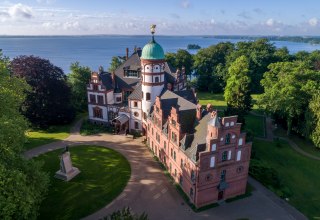The Neustädtische Palais served as the Grand Duke's temporary residence during the palace renovations and is located in the historic Puschkinstraße. With its style, characterized by French Renaissance and Baroque elements, it reflects the signature of the master builders Johann Joachim Busch and Hermann Willebrand. From a widow's residence to a grand ducal residence, it changed over the centuries and became state property in 1920.
The Neustädtische Palais, a magnificent Baroque building, was built as a temporary residence for the Grand Duke of Mecklenburg-Schwerin while construction work on Schwerin Castle was ongoing. The history of the palace dates back to 1708, when Duke Friedrich Wilhelm acquired the property for his brother Christian Ludwig. The Prinzenhof, also known as Ludwigshof, was built here and was remodeled as a widow's residence for Charlotte Sophie under Duke Friedrich's instructions from 1779. After a long period of vacancy and later use by the Minister of Finance Leopold von Plessen, the palace became the grand ducal residence during the palace renovation from 1843.
In 1883, Hermann Willebrand added a rear residential wing for Grand Duchess Marie to the building, while the overall ensemble is still characterized today by Johann Joachim Busch's redesigns in the French Baroque style. The three-winged complex with its striking mansard roof and the hall extension by Georg Adolph Demmler remains a highlight of Schwerin's architecture and conveys the splendor of Mecklenburg's ducal past. After the abdication of Grand Duke Friedrich Franz IV, the palace became the property of the Free State of Mecklenburg-Schwerin in 1920 and is now considered a valuable historical monument.
Today, the Neustädtisches Palais is home to the Ministry of Justice of the state of Mecklenburg-Vorpommern.


















